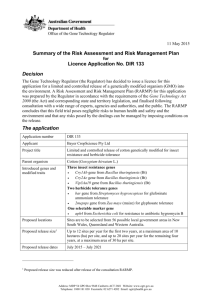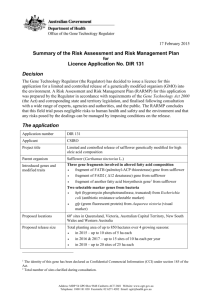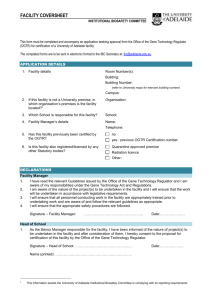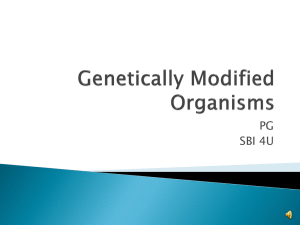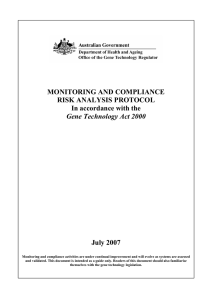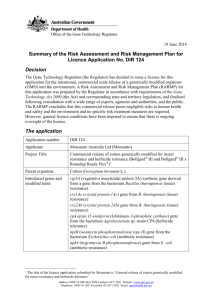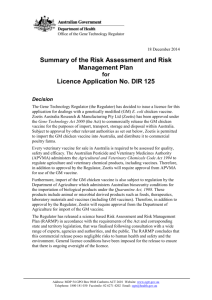DOCX format - 52 KB - Office of the Gene Technology Regulator
advertisement
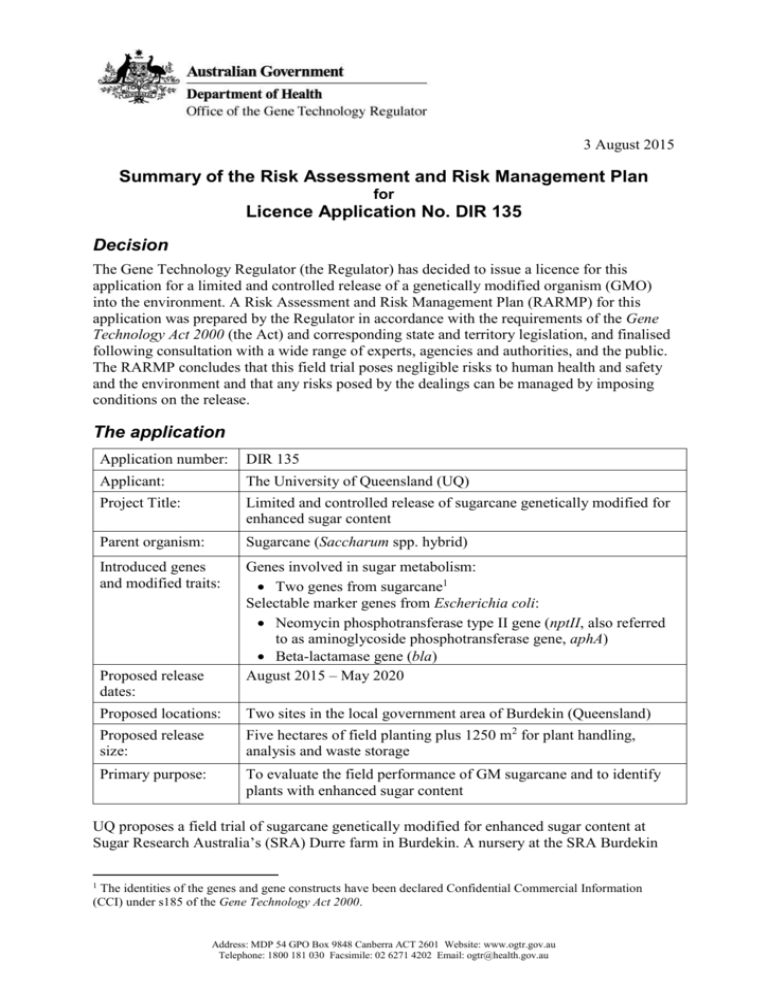
3 August 2015 Summary of the Risk Assessment and Risk Management Plan for Licence Application No. DIR 135 Decision The Gene Technology Regulator (the Regulator) has decided to issue a licence for this application for a limited and controlled release of a genetically modified organism (GMO) into the environment. A Risk Assessment and Risk Management Plan (RARMP) for this application was prepared by the Regulator in accordance with the requirements of the Gene Technology Act 2000 (the Act) and corresponding state and territory legislation, and finalised following consultation with a wide range of experts, agencies and authorities, and the public. The RARMP concludes that this field trial poses negligible risks to human health and safety and the environment and that any risks posed by the dealings can be managed by imposing conditions on the release. The application Application number: DIR 135 Applicant: The University of Queensland (UQ) Project Title: Limited and controlled release of sugarcane genetically modified for enhanced sugar content Parent organism: Sugarcane (Saccharum spp. hybrid) Introduced genes and modified traits: Genes involved in sugar metabolism: Two genes from sugarcane1 Selectable marker genes from Escherichia coli: Neomycin phosphotransferase type II gene (nptII, also referred to as aminoglycoside phosphotransferase gene, aphA) Beta-lactamase gene (bla) August 2015 – May 2020 Proposed release dates: Proposed locations: Two sites in the local government area of Burdekin (Queensland) Proposed release size: Five hectares of field planting plus 1250 m2 for plant handling, analysis and waste storage Primary purpose: To evaluate the field performance of GM sugarcane and to identify plants with enhanced sugar content UQ proposes a field trial of sugarcane genetically modified for enhanced sugar content at Sugar Research Australia’s (SRA) Durre farm in Burdekin. A nursery at the SRA Burdekin 1 The identities of the genes and gene constructs have been declared Confidential Commercial Information (CCI) under s185 of the Gene Technology Act 2000. Address: MDP 54 GPO Box 9848 Canberra ACT 2601 Website: www.ogtr.gov.au Telephone: 1800 181 030 Facsimile: 02 6271 4202 Email: ogtr@health.gov.au Office of the Gene Technology Regulator Station and a waste holding area at Durre farm will also be used. This field trial would continue the characterisation of GM plants produced in glass houses to evaluate their suitability for commercial production. Risk assessment The risk assessment concludes that there are negligible risks to the health and safety of people, or the environment, from the proposed release. The risk assessment process considered how the genetic modification and proposed activities conducted with the GMOs might lead to harm to people or the environment. Risks were characterised in relation to both the seriousness and likelihood of harm, taking into account current scientific/technical knowledge, information in the application (including proposed limits and controls), relevant previous approvals and advice received from a wide range of experts, agencies and authorities consulted on the RARMP. Both the short and long term impact were considered. Credible pathways to potential harm that were considered included unintended exposure to the GM plant material, increased potential for spread and persistence of the GM plants relative to the non-GM parent and transfer of the genetic modification to non-GM sugarcane or other sexually compatible plants. Potential harms associated with these pathways included toxicity or allergenicity to people, toxicity to other desirable organisms, and environmental harms due to weediness. The principal reasons for the conclusion of negligible risks are that the proposed limits and controls effectively contain the GMOs and their genetic material and minimise exposure; the introduced genetic modifications are unlikely to cause harm to people or the environment; and the introduced genes are common in the environment. Risk management plan The risk management plan describes measures to protect the health and safety of people and to protect the environment by controlling or mitigating risk. The risk management plan is given effect through licence conditions. As the level of risk is considered negligible, specific risk treatment is not required. However, since this is a limited and controlled release, the licence includes limits on the size, locations and duration of the release, as well as controls to separate the GM sugarcane from other sugarcane; to prohibit the use of GM plant material in human food and animal feed; to destroy GMOs not required for further studies; to transport GMOs with appropriate care; and to conduct post-harvest monitoring at the trial site to ensure all GMOs are destroyed. 2
